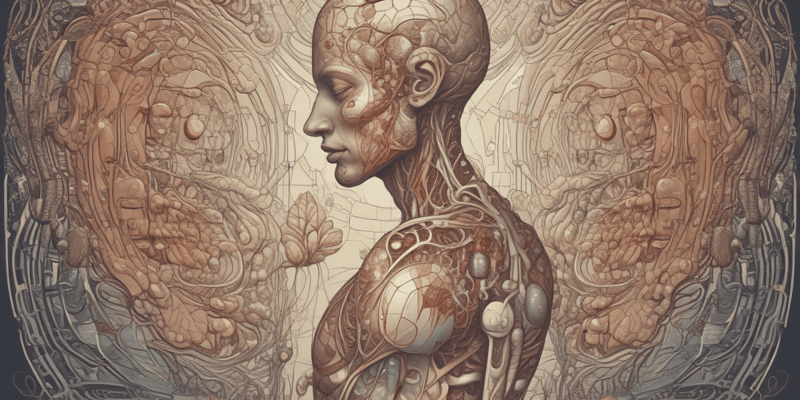Questions and Answers
Which type of receptor is responsible for detecting painful stimuli?
Nociceptors
What process allows receptors to convert physical stimuli into electrical signals?
Transduction
Which lab activity is used to test pressure sensation?
Pressure sensation test
What does cardiac output (CO) measure?
Signup and view all the answers
Which of the following is an example of a cardiovascular disease?
Signup and view all the answers
Which cells are involved in sensory transduction?
Signup and view all the answers
What kind of pain is perceived as originating on the body surface but actually occurs in internal organs?
Signup and view all the answers
What factors affect stroke volume (SV)?
Signup and view all the answers
What are the primary proteins in blood plasma, and which one is the most important?
Signup and view all the answers
Which organ produces thrombopoietin?
Signup and view all the answers
What is the primary function of erythropoietin?
Signup and view all the answers
What is the typical intrapleural pressure value during normal respiration?
Signup and view all the answers
What is the main function of Type II alveolar cells?
Signup and view all the answers
Which condition occurs when red blood cells are placed in a hypertonic solution?
Signup and view all the answers
What is the primary stimulus for the release of erythropoietin?
Signup and view all the answers
What does the term 'hematopoiesis' mean?
Signup and view all the answers
Study Notes
Sensory Modality
- Achieved through specialized receptors that detect specific stimuli (light, sound, touch, etc.) and convert them into electrical signals sent to the brain via neural pathways
- Brain processes these signals and perceives them as different senses
Cutaneous Sense Lab Activities
- Pressure sensation test
- Two-point discrimination test
- Touch localization test
Cutaneous Receptors
- Nocireceptors
- Thermoreceptors
- Mechanoreceptors
Receptor Conversion
- Receptors convert diverse physical stimuli into electrical signals through transduction
- Involves sensory transduction by a nerve cell and an epithelial cell
Referred Pain
- Pain that occurs in internal organs but is sensed on the body surface (e.g., brain freeze)
Types of Sensory Receptors
- Chemoreceptors
- Photo Receptors
- Thermoreceptors
- Mechanoreceptors
- Electromagnetic receptors
Cardiovascular Dynamics
- CO formula (cardiac output): measures the amount of blood pumped into each ventricle (ml/min)
- SV formula (stroke volume): measures the amount of blood ejected from the ventricle with each cardiac cycle (ml/beat)
- Poiseuille's Law: describes the volume rate of flow in terms of fluid viscosity, $Q=(P2-P1)\pi r^4 / 8 \eta l $
Factors Affecting Stroke Volume (SV)
- Radius
- Length
Cardiovascular Diseases
- Hypertension
- Stroke
- Congenital heart defect
- Heart failure
- Coronary heart disease
- Aortic aneurysm
Pain Control
- Body controls pain through a complex process involving the nervous system
- Pain signals are detected by nociceptors and sent to the brain via the spinal cord
- Brain processes these signals and can modulate pain perception using neurotransmitters and endorphins
Blood Composition
- Plasma makes up approximately 55% of blood, consisting of 92% water, 7% proteins, and 1% nutrients, hormones, gases, and waste products
- Proteins in blood plasma include albumin, globulins, and fibrinogen, with albumin being the most important
Blood Cells
- Eosinophils play a role in parasitic infections and allergic reactions
- Basophils are involved in inflammatory responses, especially in allergic reactions
- Lymphocytes (B cells and T cells) are responsible for specific immune responses
- Monocytes mature into macrophages, which engulf foreign particles and debris
- Neutrophils are the most abundant WBC, engulfing and destroying foreign particles and bacteria
- Mast cells play a key role in allergic reactions and inflammatory responses
Red Blood Cell Formation
- Mechanism of red blood cell formation: hematopoiesis in bone marrow, triggered by erythropoietin
- Red blood cells (RBCs) contain hemoglobin, which carries oxygen, and have an average lifespan of 120 days
Regulation of Blood Cells
- Cytokines are signaling molecules that stimulate immune responses
- Leukemia is a cancer of white blood cells
- Erythropoietin stimulates RBC production, primarily released by the kidneys in response to low oxygen levels
- Thrombopoietin stimulates platelet production, primarily produced by the liver
- Hematopoiesis is the process of blood cell formation
Platelet Function
- Platelet plug formation occurs through platelet activation, adhesion, and aggregation
- Platelets play a crucial role in blood clotting and hemostasis
Respiratory System
- Primary function of the respiratory system: exchange of oxygen and carbon dioxide between the environment and the body
- Ventilation refers to the movement of air in and out of the lungs
- Actual site of gas exchange: alveoli within the lungs
- Sequence of air route in the respiratory tree: mouth/nose, pharynx, larynx, trachea, bronchi, bronchioles, and alveoli
- Type I alveolar cells are involved in gas exchange, while Type II alveolar cells produce surfactant
- Surfactant reduces surface tension, allowing for easier expansion of the lungs
Lung Mechanics
- Diaphragm and external and internal intercostal muscles contract, causing air to move into the lungs
- Inspiration occurs when the diaphragm descends, increasing lung volume, and expiration occurs when the diaphragm ascends, decreasing lung volume
- Typical intrapleural pressure: -5 mmHg
- Tidal volume: 500 mL, vital capacity: 4600 mL, inspiratory reserve volume: 3000 mL, expiratory reserve volume: 1200 mL, residual volume: 1200 mL
Blood Flow and Pressure
- Blood flow rate and blood pressure in the lungs are lower compared to other tissues
- Causes of fibrotic lung: chronic inflammation and scarring, emphysema: damage to alveoli, leading to difficulty breathing
Studying That Suits You
Use AI to generate personalized quizzes and flashcards to suit your learning preferences.
Description
This quiz covers the basics of sensory modalities, cutaneous sense lab activities, and cardiovascular dynamics. Test your knowledge of how sensory information is detected and processed, and various lab activities related to pressure sensation, touch localization, and more.




